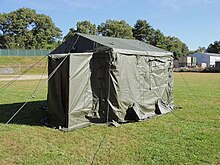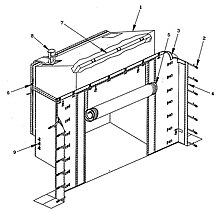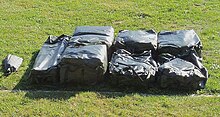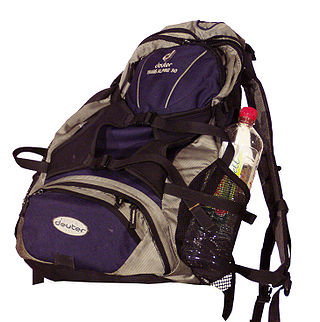
A backpack—also called knapsack, rucksack, pack, booksack, bookbag, haversack or backsack—is, in its simplest frameless form, a fabric sack carried on one's back and secured with two straps that go over the shoulders; but it can have an external or internal frame, and there are bodypacks.

A tent is a shelter consisting of sheets of fabric or other material draped over, attached to a frame of poles or a supporting rope. While smaller tents may be free-standing or attached to the ground, large tents are usually anchored using guy ropes tied to stakes or tent pegs. First used as portable homes by nomads, tents are now more often used for recreational camping and as temporary shelters.

Modular Lightweight Load-carrying Equipment, or MOLLE (pronounced MOL-lee,, is the current generation of load-bearing equipment and backpacks used by a number of NATO armed forces, especially the British Army and the United States Army.
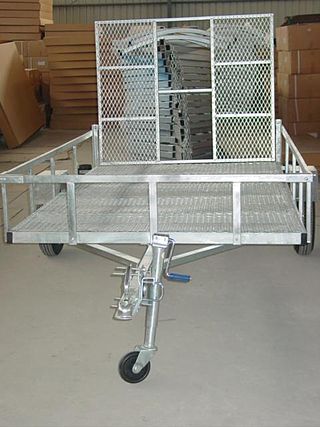
A trailer is an unpowered vehicle towed by a powered vehicle. It is commonly used for the transport of goods and materials.

A fastener or fastening is a hardware device that mechanically joins or affixes two or more objects together. In general, fasteners are used to create non-permanent joints; that is, joints that can be removed or dismantled without damaging the joining components. Steel fasteners are usually made of stainless steel, carbon steel, or alloy steel.

The Army Combat Uniform (ACU) is the current combat uniform worn by the United States Army, U.S. Air Force, U.S. Space Force and some elements of the U.S. Coast Guard. Within the Air Force and Space Force, it is referred to as the OCP Uniform, rather than the Army Combat Uniform.
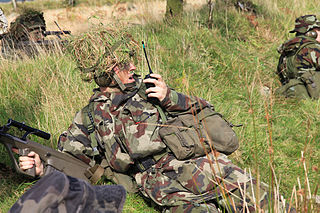
Personal load carrying equipment (PLCE) is one of several tactical webbing systems of the British Armed Forces. Dependent upon the year of design, and the decade of introduction, the webbing system was named and is commonly referred to as the 85 Pattern, the 90 Pattern or the 95 Pattern webbing.

Framing, in construction, is the fitting together of pieces to give a structure support and shape. Framing materials are usually wood, engineered wood, or structural steel. The alternative to framed construction is generally called mass wall construction, where horizontal layers of stacked materials such as log building, masonry, rammed earth, adobe, etc. are used without framing.
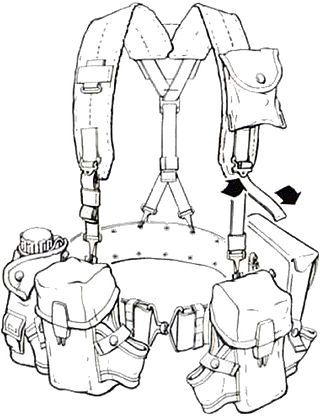
The All-purpose Lightweight Individual Carrying Equipment (ALICE) is a set of load-carrying equipment adopted as United States Army Standard A on 17 January 1973 to replace the M-1956 individual load-carrying equipment (ILCE) and M-1967 modernized load-carrying equipment (MLCE). Although since superseded by MOLLE, ALICE gear is still in some limited use with the U.S. Army National Guard, State Guard, also some ground units of the Navy and Air Force.

The M136 Volcano Vehicle-Launched Scatterable Mine System is an automated mine delivery system developed by the United States Army in the 1980s. The system uses prepackaged mine canisters which contain multiple anti-personnel (AP) and/or anti-tank (AT) mines which are dispersed over a wide area when ejected from the canister. The system, commonly referred to as Volcano, is also used by other armies around the world.
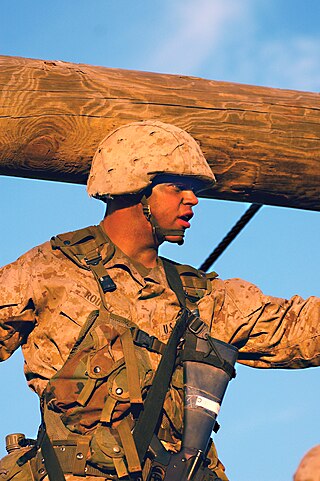
The IIFS was introduced in 1988, to serve as a fighting and existence carrying system—a possible replacement for the all-purpose lightweight individual carrying equipment (ALICE) employed and fielded by United States Armed Forces since 1973.

The Volkswagen Westfalia Camper was a conversion of the Volkswagen Type 2, and then, the Volkswagen Type 2 (T3), sold from the early 1950s to 2003. Volkswagen subcontracted the modifications to the company Westfalia-Werke in Rheda-Wiedenbrück.

A zipper storage bag,slider storage bag,zipper bag,zip lock bag, or zippie is an inexpensive flexible rectangular storage bag, usually transparent, made of polyethylene or similar plastic, that can be sealed and opened many times, either by a slider, which works in a similar way to a zip fastener, or by pinching together the two sides of a mechanical sealing mechanism with one's fingers. The bags are made in many sizes; a typical small size is 1.5 by 2.5 inches, and a typical large size is 9 by 12 inches. Material thickness (gauge) varies; smaller bags are typically 40 to 45 μm.
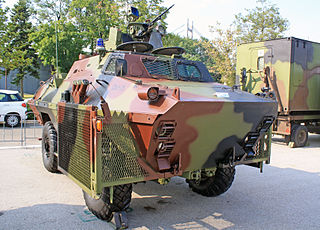
The BOV, is an all-wheel drive armoured vehicle manufactured in the former Yugoslavia and today in Serbia. The second generation BOV is currently in development.

The M1120 HEMTT LHS is a M977 Heavy Expanded Mobility Tactical Truck with a load handling system in place of a flat bed/cargo body. The HEMTT is an eight-wheel drive, diesel-powered, tactical truck used by the US military and others. The HEMTT is manufactured by Oshkosh Defense and entered Army service in 1982, with the M1120 variant first produced in 1999.

The Future Tactical Truck System (FTTS) was a United States Armed Forces program for which the Operational Requirements Document was drawn up during 2003. FTTS was a proposed two vehicle modular family that was to replace the AM General High Mobility Multipurpose Wheeled Vehicle, Family of Medium Tactical Vehicles (FMTV), Oshkosh M977 Heavy Expanded Mobility Tactical Truck (HEMTT), Palletized Load System (PLS), and all remaining M35, M809 and M939 series of 2.5 and 5 ton trucks. The FTTS-UV was to replace the HMMWV, while the FTTS-MSV was to replace all other types.
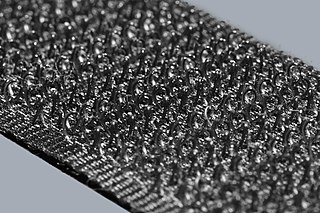
Hook-and-loop fasteners, hook-and-pile fasteners or touch fasteners, are a method for allowing two surfaces to be repeatedly fastened and unfastened, useful for clothing or other purposes. The fastener consists of two components: typically, two lineal fabric strips which are attached to the opposing surfaces designed to be fastened together. The first component features tiny hooks and the second component features smaller loops; When the two are pressed together, the hooks catch in the loops and the two pieces fasten or bind temporarily. When separated, which can be done by pulling or peeling the two surfaces apart, the strips make a distinctive ripping sound.
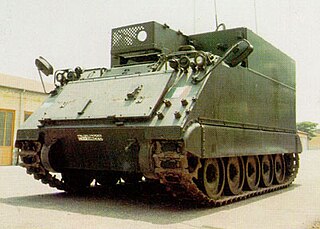
The M577 command post carrier, also known as the M577 command post vehicle or armored command post vehicle, is a variant of the M113 armored personnel carrier that was developed and produced by the FMC Corporation to function on the battlefield as a mobile command post i.e. a tactical operations centre, usually at the battalion level. In U.S. military service its official designation is Carrier, Command Post, Light Tracked M577.
